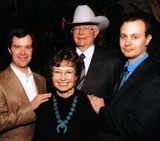Living with Weapons Near the Bed in Arizona
By: Amos S. Eno
Posted on:09/02/2011Drug trafficking and illegal border crossings from the perspective of a rancher
This is our final post in the series about the Chilton Ranch located along Arizona’s southwestern border with Mexico.
As with previous posts about border ranches of the Malpais, this series about Jim and Sue Chilton and their ranch must end on an uncertain note. Despite his determination and his success at managing his natural resources adaptively, defending himself from unfair accusations, and dealing with the uncertainties and adversity of existence in a harsh climate, there is one threat that makes Jim and his family feel helpless: the threat of violence from lawless invaders from across the border.

“I’m speaking mostly of the armed thugs and vehicular traffic that are associated with drug running,” says Jim. “We feel for the people who are desperate enough to risk their lives for a chance at honest work in this country. But our ranch house and headquarters are located 19 miles from our 5 miles of border fence with Mexico. We’ve been burglarized twice by drug packers on their way back to Mexico. Our losses have been great, and our sense of security in our own country has been severely damaged. We live with weapons near our bed, at the doors, in our vehicles and attached to our saddles.”
Testimony Before the House of Representatives
As I mentioned at the beginning of this blog series, Jim testified in April 2011 at the House Joint Subcommittee Oversight Hearing on "The Border: Are Environmental Laws and Regulation Impeding Security and Harming the Environment?" His full testimony reads almost like a harrowing novel, with plot twists that prove the saying ‘life is stranger than fiction.‘
Jim’s essential point, taken from his testimony, is that “We must not tie up our national defense at the border with red tape.” For someone like me, who worries about the wildlife impacts of a continuous insurmountable fence across all 1,970 miles of the US-Mexico border, Jim’s testimony was sobering. My fear is that the war on drugs next door is too close for comfort or for safety, and when safety is at stake, of course, all other concerns go out the window.
As Jim pointed out in his testimony, “We see real environmental damage, not the exaggerated false claims about grazing, but real damage resulting from the failure to control the border at the border. . . The constant cross-country driving and the on and off-road illegal vehicle traffic, visibly damage plants and animal habitat and cause erosion and litter for miles inside the border."
To quote from his testimony, “This situation is not confined to our ranch but is absolutely typical on every border ranch. To address a bit of the problem, hunting groups conduct huge garbage collection drives on border ranches each year just to make a dent in the plastic milk jugs, plastic bags and unmentionable other items littering the border area. If the Border Patrol controlled the border at the border, the environment 50 and 100 miles into America would no longer suffer this genuine abuse.
“Most all ranchers in the border area can not leave their houses [unguarded], since experience demonstrates that their homes will certainly be broken into if someone is not there. Ranchers along the border can not have peace of mind until the border is secured,” concludes Jim’s testimony.
The ranchers of Arizona are few compared to the populace of a Tucson or a Phoenix or a Denver. The question that we must all ask ourselves is, if the safety and the historic productive culture of Arizona ranchers can be sacrificed - no matter what the reason - what does that mean for the rest of us? What happens if the ranchers give up?
The disappearance of the western border rancher would mean more than the loss of a quintessentially American cultural icon - it could very well be the first domino in the decline of every American’s way of life.

 Sign In
Sign In
 Sign In
Sign In
